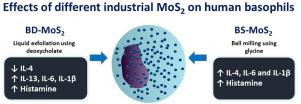NanoImpact ( IF 4.9 ) Pub Date : 2023-01-07 , DOI: 10.1016/j.impact.2023.100451 Hazel Lin 1 , Antonio Esau Del Rio Castillo 2 , Viviana Jehová González 3 , Lucas Jacquemin 1 , Jaya Kumar Panda 2 , Francesco Bonaccorso 2 , Ester Vázquez 3 , Alberto Bianco 1

|
MoS2 has been increasingly used in place of graphene as a flexible and multifunctional 2D material in many biomedical applications such as cancer detection and drug delivery, which makes it crucial to evaluate downstream compatibility in human immune cells. Molybdenum is a component of stainless-steel stent implants and has previously been implicated in stent hypersensitivity. In view of this, it is important to ascertain the effect of MoS2 on allergy-relevant cells. Basophils are a less commonly used immune cell type. Unlike mast cells, basophils can be easily derived from primary human blood and can act as a sentinel for allergy. However, merely testing any one type of MoS2 in basophils could result in different biological results. We thus decided to compare 2D MoS2 from the two companies BeDimensional© (BD) and Biograph Solutions (BS), manufactured with two different but commonly exploited methods (BD, deoxycholate surfactant in a high-pressure liquid exfoliation, and BS using glycine in ball-milling exfoliation) to elucidate immunological end-points common to both MoS2 and to demonstrate the need for biological verification for end-users who may require a change of supplier. We report higher histamine production in human basophils with MoS2. No effects on either surface basophil activation markers CD63 and CD203c or reactive oxygen species (ROS) production and cell viability were observed. However, different cytokine production patterns were evidenced. IL-6 and IL-1β but not TNF and GM-CSF were increased for both MoS2. BS-MoS2 increased IL-4, while BD-MoS2 decreased IL-4 and increased IL-13. Molybdate ion itself only increased IL-1β and IL-4. Deoxycholate surfactant decreased viability at 18 h and increased ROS upon basophil activation. Therefore, these results demonstrate the safety of MoS2 in human basophils in general and highlight the importance of considering manufacturer additives and variability when selecting and investigating 2D materials such as MoS2.
中文翻译:

工业化生产的二维二硫化钼材料对人原代嗜碱性粒细胞的影响
MoS 2作为一种灵活的多功能二维材料,越来越多地用于替代石墨烯,用于许多生物医学应用,例如癌症检测和药物输送,这使得评估人体免疫细胞的下游相容性变得至关重要。钼是不锈钢支架植入物的成分,以前曾与支架过敏有关。鉴于此,重要的是确定MoS 2对过敏相关细胞的影响。嗜碱性粒细胞是一种不太常用的免疫细胞类型。与肥大细胞不同,嗜碱性粒细胞可以很容易地从原代人血液中提取,并且可以作为过敏的哨兵。然而,仅测试任何一种类型的 MoS 2在嗜碱性粒细胞中可能会导致不同的生物学结果。因此,我们决定比较来自 BeDimensional© (BD) 和 Biograph Solutions (BS) 这两家公司的 2D MoS 2,它们采用两种不同但常用的方法制造(BD,高压液体去角质中的脱氧胆酸盐表面活性剂,以及使用甘氨酸的 BS球磨去角质)以阐明 MoS 2共有的免疫学终点,并证明对可能需要更换供应商的最终用户进行生物验证的必要性。我们报告了 MoS 2在人嗜碱性粒细胞中产生更高的组胺. 未观察到对表面嗜碱性粒细胞激活标记 CD63 和 CD203c 或活性氧 (ROS) 产生和细胞活力的影响。然而,证明了不同的细胞因子产生模式。IL-6 和 IL-1β 但不是 TNF 和 GM-CSF 对于两种 MoS 2都增加了。BS-MoS 2增加IL-4,而BD-MoS 2减少IL-4并增加IL-13。钼酸根离子本身只增加IL-1β和IL-4。脱氧胆酸盐表面活性剂在 18 小时时降低了活力,并在嗜碱性粒细胞激活后增加了 ROS。因此,这些结果总体上证明了 MoS 2在人嗜碱性粒细胞中的安全性,并强调了在选择和研究二维材料(例如 MoS)时考虑制造商添加剂和可变性的重要性2 .



























 京公网安备 11010802027423号
京公网安备 11010802027423号